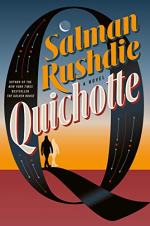
|
| Name: _________________________ | Period: ___________________ |
This test consists of 5 short answer questions, 10 short essay questions, and 1 (of 3) essay topics.
Short Answer Questions
1. Jonesco mysteriously examines which parts of Quichotte and Sancho's bodies in the novel's twelfth chapter?
2. Which character "sometimes" has the "strange thought" (152) that maybe someone had created Quichotte just like Quichotte had created him?
3. When Rushdie uses a gambling metaphor in Chapter 13, he portrays Quichotte as "betting on" (192) what?
4. Who tells Brother and Ex-Wife that Son is alive and well, but he does not want to be contacted?
5. What type of accent does Jonesco have, according to the narrator?
Short Essay Questions
1. What odd accessory does Sancho notice around the white lady's neck as he and Quichotte leave Lake Capote?
2. What element does Sancho decide is the "key to survival" (129) in life and what is the source of his conclusion?
3. How do Son's parents discover what happened to Son after his sudden disappearance?
4. How do Quichotte and Sancho escape from the mastodons in Berenger, New Jersey?
5. What is the significance of Brother's encounter with the "mosaic portraits of authors and musicians" (213) in the subway station?
6. What is the symbolism of Babajan's laugh, as revealed in the novel's eleventh chapter?
7. Describe the weather that greets Quichotte and Sancho when they finally arrive in New York City and discuss its significance.
8. To what creature does Rushdie compare Quichotte as he is "driving the Cruze out of the Lincoln Tunnel into Manhattan" (192) and why?
9. Discuss an instance of foreshadowing used within Part Two of Quichotte.
10. For what reason do Quichotte and Sancho visit Lake Capote in Colorado?
Essay Topics
Write an essay for ONE of the following topics:
Essay Topic 1
What ultimate message is Rushdie sending about the characteristics of life in the United States?
Essay Topic 2
Analyze the interplay between the resolution of Quichotte and one of the novel's main messages. How does Rushdie make connections between these elements and how does their juxtaposition help them get across one main message of the novel?
Essay Topic 3
Read a lengthy interview with Rushdie. Write an essay explaining the connection between several of Rushdie’s answers and a major theme presented within the text of Quichotte.
|
This section contains 1,175 words (approx. 4 pages at 300 words per page) |

|




